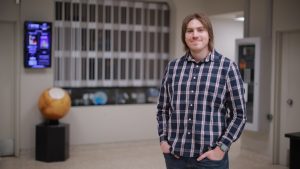The University of Toledo has proven to be a gateway for Grant Donnelly.
Since he began a doctoral program in physics with a concentration in astronomy in 2020, Donnelly has been to Flagstaff, Arizona, to observe the night sky under a former partnership between UToledo and the Lowell Observatory. He’s been to Pasadena, California, to dig into James Webb Space Telescope data during a prestigious six-month fellowship on the campus of the California Institute of Technology. And he’s been to Hiroshima, Japan, to present on a massive archival data project for the decommissioned Spitzer Space Telescope at the conference Dust and Gas Throughout Cosmic Time.

Grant Donnelly, a doctoral student in physics with a concentration in astronomy, studies tiny molecules called polycyclic aromatic hydrocarbons or PAHs.
Now, with the recent success of his own proposal to use the James Webb Space Telescope, he’ll soon be setting his sights on a galaxy more than 52 million light-years from Earth.
“I don’t think I would have been able to say any of that if I hadn’t come to UToledo,” Donnelly said. “I’ve had a lot of luck, but they say that luck is when opportunity meets preparation. UToledo has given me the opportunities.”
Donnelly’s interest in astronomy research began as an undergraduate student at John Carroll University outside Cleveland, where a visiting professor presented him a hands-on introduction through John Carroll’s Summer Undergraduate Research Fellowship.
UToledo proved the most attractive option for continuing his education — and not only for its relative proximity to family back home in Mentor, Ohio. Donnelly recalled being impressed by the opportunity to join a student observing team and engage with the research-grade telescope in Ritter Observatory, and, perhaps more significantly, by the international reputations of the astronomers he would be working alongside.
“I can appreciate that even more so now,” he said. “Everywhere I go for a conference, even out of the country, people will know the astronomers I’m working with. We have a phenomenal program here, and we’re recognized for that, it seems like, everywhere I go.”
Astronomy and astrophysics are an area of research excellence at UToledo, contributing to the University’s prestigious Carnegie R1 Classification announced in February. UToledo is one of only 187 higher education institutions in the country recognized for very high research activity by the Carnegie Classification of Institutions of Higher Education.
At UToledo Donnelly works closely with his advisor, Dr. J.D. Smith, a professor of astronomy and director of the Ritter Astrophysical Research Center. Both astronomers specialize in what’s called the interstellar medium, the gas and dust that exist between stars, with a particular interest in tiny molecules called polycyclic aromatic hydrocarbons or PAHs.
It’s this research that positioned Donnelly well for his Infrared Processing and Analysis Center (IPAC) Visiting Graduate Student Fellowship on the campus of Caltech in 2024. Working alongside a staff astronomer at the research center that partners with NASA, its Jet Propulsion Laboratory and the world-wide research community, Donnelly explored how PAHs show up in images taken by the James Webb Space Telescope.
His peer-reviewed research, describing a method that astronomers can employ to accurately interpret the images they obtain, was published this week The Astrophysical Journal.
Donnelly was in Pasadena between February and August. When he wasn’t poring over data during the week, he was enjoying his surroundings in sunny California.
“I’d never lived out of state for any significant amount of time, so California was very different, but I loved every single second of it,” he said. “I had the opportunity to do all sorts of touristy things. I went to the Grand Canyon for the first time; I went to San Francisco and San Diego. It was an incredible experience.”
In June Donnelly is set to head to Charlottesville, Virginia, to participate in the Kavli Summer Program in Astrophysics on the campus of the University of Virginia. The prestigious six-week workshop that hosts up to 15 established faculty, 15 post-doctoral researchers and 15 graduate students blends classroom instruction with research.
This year’s theme is “Cool Frontiers: Exploring Dust and Ice in the Cosmos.”
Donnelly is now back on campus and preparing to continue his exploration of space dust through another high-profile opportunity. In March, he learned that he would be leading his own observing program on the James Webb Space Telescope — a remarkable achievement, his advisor points out, given that only 274 of 2,377 proposals made the cut in this fourth and latest cycle of scheduled observing time.
That accounts for a success rate of less than 12%.
“Grant’s success is remarkable on many levels,” Smith said. “But it’s also not surprising. As a researcher, Grant combines strong technical skills with a powerful ability to communicate ideas clearly and simply — just the combination needed to catch the eye of James Webb Space Telescope proposal reviewers.”
Donnelly advances an impressive record of engagement with the telescope at UToledo, where faculty and student astronomers have led at least one research project on each cycle of scheduled observing time since it launched in December 2021.
In his three allocated hours, Donnelly will collect infrared spectral data from the spiral galaxy NGC 4151. When added to more than 25 hours’ worth of archived data, it will complete a uniform set of observations of NGC 4151 and four other galaxies.
“There’s an important wavelength where we can see one specific spectral feature of the PAHs, and we don’t have it yet for this galaxy that happens to have a really luminous active galactic nuclei (AGN),” Donnelly explained. “We made what we hoped was a convincing argument to the telescope allocation committee that we could answer interesting questions about how the AGN and PAHs interact if we have the missing piece of this galaxy.
“And we got it,” he continued. “I was incredibly, incredibly, incredibly excited.”